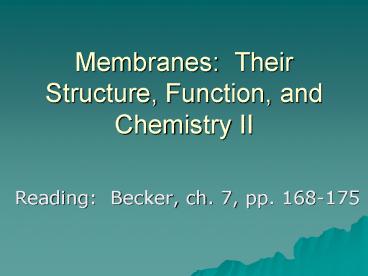Membranes: Their Structure, Function, and Chemistry II
1 / 17
Title:
Membranes: Their Structure, Function, and Chemistry II
Description:
Extraction: isolation of a particular type of macromolecule ... Separates lipids according to their degree of hydrophobicity. A Review of Fatty Acid Structure ... –
Number of Views:270
Avg rating:3.0/5.0
Title: Membranes: Their Structure, Function, and Chemistry II
1
Membranes Their Structure, Function, and
Chemistry II
- Reading Becker, ch. 7, pp. 168-175
2
Not All Membranes Are Alike!
3
Identification of Lipids
- Extraction isolation of a particular type of
macromolecule from cells by taking advantage of
unique chemical properties - Cell disruption (lysis)
- Cell contents dissolved in organic solvent
(non-polar, - usually chloroform)
- Non-polar lipids will dissolve readily
- Centrifugation to separate into organic and
aqueous phases - Lipids will separate into lower, heavier
organic phase - Collection of the organic phase, containing
cellular lipids
4
Identification of LipidsTLC (Thin-Layer
Chromatography)
Hydrophilic silica plate (stationary phase)
Extracted lipids
Organic solvent system (mobile phase)
Separates lipids according to their degree of
hydrophobicity
5
A Review of Fatty Acid Structure
6
Membrane Asymmetry
- The inner and outer leaflets of membrane bilayers
are NOT identical - Glycolipids predominantly in the outer leaflet,
with carb groups extending into extracellular
space - Phospholipids predominantly in inner leaflet
- If the 2 leaflets of the bilayer are
biochemically distinct, what does this imply?
7
Membrane Asymmetry
- Membrane asymmetry is relatively fixed
- Transverse diffusion is rare
- energetically unfavorable catalyzed by enzymes
called flippases or phospholipid translocators - Lateral diffusion and rotation are common
8
Membrane Fluidity
- Fluidity of membrane is affected by saturation
level of fatty acid tails
9
Lateral Diffusion
- Fluorescence Recovery After Photobleaching (FRAP)
10
The Importance of Membrane Fluidity
- Membranes must be fluid in order to function
properly - Critical for transport of molecules
- Critical for proper function of membrane proteins
requiring conformational changes
11
Transition Temperature
- The temperature at which the membrane changes
from a fluid to a gel state - Tm
- Below the Tm, the membrane will be gel-like and
function will be compromised
12
Membrane Fluidity
- Fluidity is affected by saturation level of fatty
acids - Fluidity is affected by length of fatty acid
chains - Longer fatty acids freeze faster
- (i.e., at higher temperatures)
13
Membrane Fluidity
14
Membrane Fluidity
- Fluidity is affected by saturation level of fatty
acids - Fluidity is affected by length of fatty acid
chains - Fluidity is affected by presence of sterols
15
Sterols Affect Membrane Fluidity
- Equal amounts of sterols are found in the two
layers of the bilayer
Rigidity of sterol ring structure decreases
fluidity at high temps increases fluidity at low
temps
16
Homeoviscous Adaptation
- Ability of organisms to change phospholipid
composition of membranes to maintain proper
membrane fluidity upon extreme temperature change
17
Homeoviscous Adaptation
- Important for poikilotherms
- With decreasing temp
- Shortening fatty acid chains within PM decreases
transition - temp so that membrane remains fluid
- Micrococcus activates enzyme that chops 2 Cs
off of - existing 18 C fatty acid chains
- Increasing saturation of fatty acid chains within
PM also - decreases transition temp so that membrane
remains fluid - E. coli synthesizes desaturase, enzyme that
introduces - double bonds into hydrocarbond chains of fatty
acids, which - will then be incorporated into new membrane lipids































